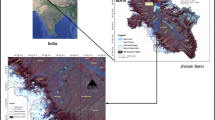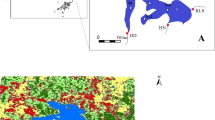Abstract
Jakkur Lake in the city of Bengaluru covers an approximate area of 55 hectares and primarily receives inflows from the Jakkur sewage treatment plant (STP) and an open storm drain. Jakkur STP discharges an average of 10 million litres of treated water daily (MLD) into the lake. The open drain discharges about 0.5 MLD of raw sewage into the lake. In the absence of environmental flows it becomes critical to assess the impact of nutrient flux on the quality of water, and design cost effective treatment solutions to address the issues of lake water quality. As part of this study, we have assessed the impact of these two primary inflows on the overall water quality of Jakkur Lake. The results have shown that nutrient inflows have led to the increase of chlorophyll-a levels, eventually causing hypereutrophication of Jakkur lake. We have also used simple mass balance approach to assess the contributions of in-lake activities (sedimentation and reaction) on removal of nutrients from the lake. We have concluded that the phosphorus load has to be reduced by approximately 96% from the current levels to prevent algal blooms within Jakkur Lake.
Similar content being viewed by others
Suggested Reading
P Jamwal, T Md Zuhail, P Raje Urs, V Srinivasan and S Lele, Contribution of sewage treatment to pollution abatement of urban streams. Curr. Sci., 108, pp. 677–685, 2015.
P Jamwal, K Bejoy Thomas, S Lele and V Srinivasan, Addressing water stress through wastewater reuse: Complexities and challenges in Bangalore, India, 2014.
More than 90% of Bangalore’s lakes are polluted or encroached. Available at: http://www.indiawaterportal.org/articles/more-90-bangalores-lakesare- polluted-or-encroached. (Accessed: 27th January 2017).
CPCB, Water Quality Criteria, (Central Pollution Control Board, 2012).
Fish kill in Jakkur lake. Available at: http://www.deccanherald.com/content/34512/flshkill- jakkur-lake.html. (Accessed: 31st January 2017).
Ulsoor lake flshkill: Plunder of nature, Deccan Herald Available at: http://www.deccanherald.com/content/534510/ulsoor-lake-flshkill-plundernature. html. (Accessed: 31st January 2017).
BWSSB plugs leakage at STP, checks flow of sewage into Jakkur lake. Available at: http://www.deccanherald.com/content/453195/bwssb-plugs-leakagestp- checks.html. (Accessed: 31st January 2017).
APHA, Standard Methods for examination of water and wastewater, (APHA, 2005).
US EPA Nutrient Criteria Technical Guidance Manual Lakes and Reservoirs, First Edition, 2000.
Proyecto agua/water & project, Chlorophyll - chlorophyll.pdf. enr.gov.nt.ca Available at: http://www.enr.gov.nt.ca/sites/default/flles/chlorophyll.pdf. (Accessed: 31st January 2017).
Author information
Authors and Affiliations
Corresponding author
Additional information
Priyanka Jamwal is an environmental researcher in ATREE. Her work focuses on identiflcation of contaminant sources in surface water bodies, modelling the fate and transport of contaminants in urban hydrological systems, and assessing the risk to human health on exposure to contaminants.
Rights and permissions
About this article
Cite this article
Jamwal, P. Fate of nutrients in human dominated ecosystems. Reson 22, 279–290 (2017). https://doi.org/10.1007/s12045-017-0460-7
Published:
Issue Date:
DOI: https://doi.org/10.1007/s12045-017-0460-7




